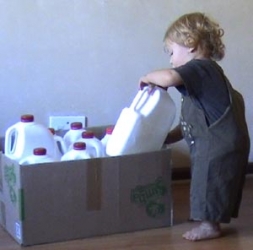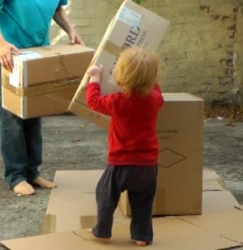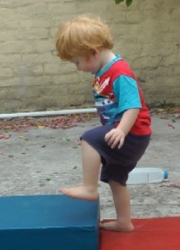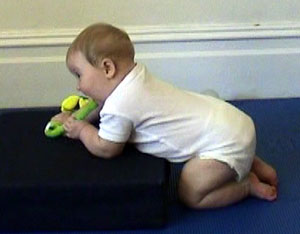Task Oriented Movement Training and Therapy for Infants and Toddlers, in keeping with other task oriented, function focused approaches to early intervention (EI), starts with the assumption that infants and toddlers only learn new skills when they actively engage in exploring their environment and try out different options for achieving their goals.
Why a context/task oriented, function focused approach?
In recent years there has been a shift away from the almost exclusive use of process based approaches to intervention, such as neurodevelopmental therapy (NDT) and sensory integration therapy (SI) towards using task and context oriented approaches, with an emphasis on improving function and participation.
There are two basic reasons for changing from a process to a task/context based approach: ,
Firstly the evidence shows that task based approaches are more effective in bringing about changes in infant and children’s motor abilities and participation.
The second reason is that advances in our understanding of motor development, control and learning from the latest neuroscience research literature provides a host of new insights into the many factors that contribute to task performance – and how the specifics of motor control are tightly linked to the task and context.
In other words, you cannot separate perceptual motor control from the context and task demands.
|
Each new standing task a toddler masters has different requirements for trunk stability and maintaining balance - these requirements are specific to the task, and learning a new task involves adapting available solutions to the new task. This means that a toddler's balance abilities can only be trained in relation to a specific task. |
TOMT adopts a constraints led approach to motor learning
A constraints led approach to motor learning is based on the understanding that an infant or toddler's ability to successfully achieve a desired movement goal resides in the interaction between the task, the individual child and the social and physical environment (T-I-E).
Factors within the child, the task or the environment can either constrain or promote the infant or child's ability to successfully complete a task.
|
Transitioning from prone to prone kneeling in readiness for crawling requires good upper limb strength and trunk stability.
Infants who have not learned to push up into extended elbow support in prone lack the strength and control to push up into prone kneeling. Upper limb strength is a constraining factor. Letting the infant kneel at a low step changes the biomechanics of the action so that pushing up onto extended arm support requires less muscle strength. The task has been adapted. In this position the infant learns to control balance and transition from kneeling to sitting. As the infant's confidence, control and strength improve, the step can be lowered.
|
TOMT training principles
The TOMT approach embraces the principles that are common to all modern evidence based, task focused early intervention approaches.
1 Active infant engagement is essential for learning
TOMT as intervention strategy starts from the premise that infants learn new skills when they actively engage in intentional exploratory behaviors, which may or may not be goal directed.
An infant’s ability and willingness to actively engage with the environment determines the quality of learning that occurs.
Therefore it is vitally important to find ways to engage the infant and develop his desire and ability for exploration and interaction.
2 Infants only learn when they are alert and interested in the task at hand.
A crying, unhappy infant learns nothing other than that the physical therapist is a not a nice person.
3 Independent action is important for learning
Infants are encouraged to engage independently with the task, in an effortful way, to reach new goals. They are encouraged to to find their own solutions to the movement problem.
Independent action means that the infant acquires an ever expanding set of solutions to different movement problems and builds up his/her store of action plans. Success breeds success.
Allowing infants time and opportunity to successfully achieve their goals increases their sense of I-can-do and self efficacy. The infant starts to expect more of him/herself - as do therapists and caregivers. This is particularly important for infants whose motivation to move is not good.
Infant's are very aware of their own successes - and will often share their pleasure with social partners.
Video clip: Will 7 months: prone to prone kneeling
This clip very nicely illustrates the persistence and exploration of options when working towards a goal - in this case reaching for a cloth flower.
5 Frequency of practice
Typically developing infants spend a great deal of time working on new skills. The will repeat the same activity or action repeatedly until they get it right.
Infants with motor difficulties are often less motivated to move. They need repeated opportunities, in a supportive environment, for working on their motor skills, as well adaptation of tasks to allow them to succeed.
Task practice needs to be embedded into daily routines to ensure that the infant gains the repeated experience needed for learning and improving perceptual motor skills.
6 Family centered intervention
When families are involved in the selection of goals they are more motivated to put effort into training and practice.
Task based goals, training and practice allows parents to see the progress their infant is making.
7 All therapy should be grounded in a positive relationship
A large part of a therapist's job is to create a a social environment that responds in a sensitive manner to the infants goals and intentions.
The therapist should value and honor the feelings and needs of the infant in a way that promotes alert and happy engagement in whatever tasks or activities you are busy with. Read more







